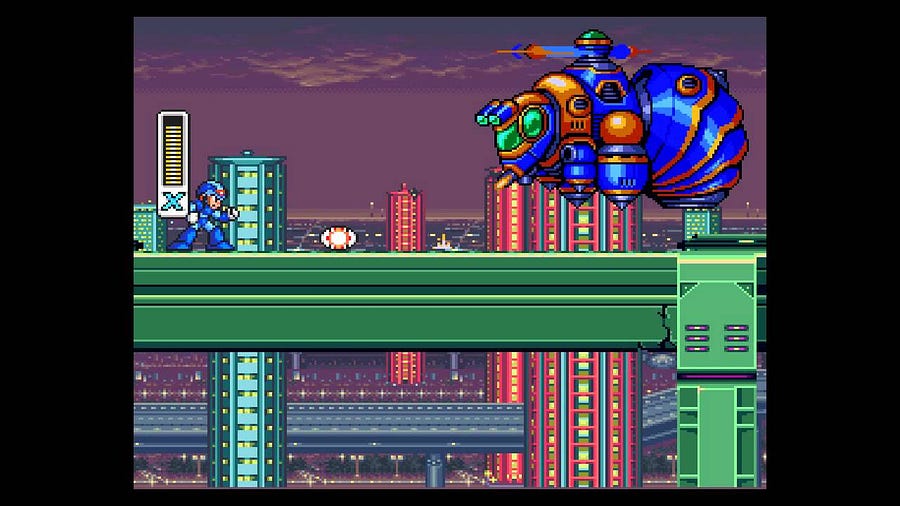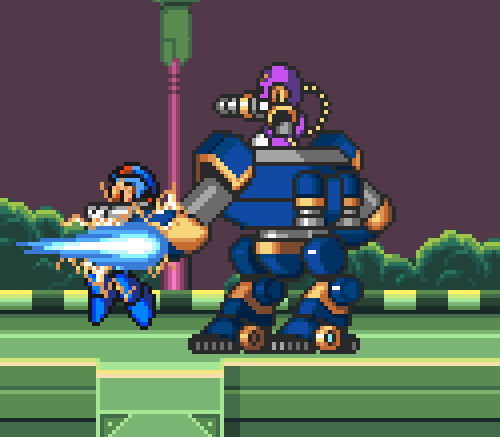How Mega Man X changed how I felt about videogames
The year was 20XX…
Or at least it was the mid-90s in our house in Norfolk. Dad was working nightshifts and I was around nine or 10 years old. I remember vaguely waking up when my mum asked my dad when he got in one morning if he’d got it.
It turned out to be a Super Nintendo. He’d bought it from some guy at work and it had nine games with it. In the relative pre-internet days, I have no idea how my dad knew what a Super Nintendo was or whether he was paying a decent price for it. It came with Mario World, Kart, Alien 3, Spiderman and a few other games I don’t really remember.
It also came with Mega Man X, which as someone who’d learned Roman numerals in Year 4, thought meant it was Mega Man Ten. I was familiar with the concept of the series. You play a robot and in a series of side-scrolling levels, get to the boss area, duel with the (always a man) boss, beat him and acquire his weapon.

I remember Mega Man 1 being insanely difficult and to this day I haven’t completed it. In mitigation, it’s because the boss fights were too random, but also the disappearing blocks frustrated me to the point that even with save states, I couldn’t navigate my way to the end of a couple of stages. The “phooo” noise of those blocks will haunt me for decades. It also didn’t have an intro level. Press Start and you’re straight into a choice of six robots.
Welcome to Central Highway
The X series, from the start, is different. Hit start and you’re teleported to a new world. Central Highway is the first level, with minimal introduction you’re dropped in to a dystopian background of smoking cars travelling the other way. The first enemy you encounter is a spiked wheel — official name Spiky — hurtling towards you. You can take it out with a charged shot, but if you hit it twice, it will fall towards you — an unexpected, clever touch.
The whole point of the level, with the urgent music, mid-range enemies trying to knock you into the abyss and an unbeatable boss is to show you how weak you are when you first play. You run at a relatively slow speed without the dash and some of the jumps look impossible. I’d have loved to see the area revisited before the final level perhaps, with all of X’s weapons and abilities available to see just how far the player has come. Even with the dash, the level would be ludicrously easy.

One of the first big enemies you encounter is a giant blue bee robot that hovers, firing bullets and deploying weak robots on stilt-like legs. Although the bee is big, it’s not a difficult battle and when you take it out, it collapses the weakened bridge falling to the floor. In the normal series, this couldn’t happen, but in the X series, it’s your introduction to wall-jumping.
Wall jumps change the entire mechanics of the franchise, giving it a key point of difference to the normal series. Jump on a wall and you’ll slide down until you jump again, allowing you to scale great heights. Imagine Knuckles’ wall ability, but smoother. Just beyond the bee and separated by a wall, you can see an energy capsule. It’s an inducement to wall jump and teaches you that it pays to explore. Later in the game, you can wall jump, dash off the wall, turn round and fire at an enemy. It’s incredibly satisfying and several of the game’s puzzles can be solved with it.
The next part of Central Highway sees the level begin to collapse. You can’t stand around for too long as the platforms will fall. It doesn’t seem so bad, because you now know you can aim for the side of a wall and hop up if you need to, but then, after negotiating your way through robots on cars, an airship descends and the music gets ominous. Vile.

Again, there’s no introduction, just a Boba-Fett looking purple robot in a ride armour. In the original, you can fight for as long as you want, you cannot beat him. And even though you can’t beat him, he can beat you! Without knowing this, I lost more than one life to Vile, frustrated that I couldn’t beat this enemy and why would there be a game where I can’t win? It was only by accident that he caught me with the shot that immobilises X and advances the story with Zero, bringing up the central hub of bosses.
“Step into this capsule, X…”
The bosses are no longer humanoid, but Maverick robots based on animals, creating another key point of difference. Chill Penguin, Spark Mandrill, Boomer Kuwanger (it’s a beetle, apparently). Intimidating music kicks in and as X has come through a battle against an unbeatable ride armour, perhaps going after the 7-foot mammoth isn’t a good idea.
Wall jumping works against most of the bosses, and Capcom had to think about this when designing boss fights. Instead of running and firing in largely vanilla boss rooms in the original series, suddenly boss fights had environmental elements to them with Storm Eagle trying to knock you off the ship or Launch Octopus’ underwater lair. Most of the Maverick bosses have an anti-wall jump move, like Flame Mammoth jumping straight into the air or Armoured Armadillo hurtling around the room. It’s really well-thought out and increases the intensity of each fight. You can survive happily by hitting the top corner of the boss room and ducking down occasionally, but it’s best only for a breather because they’ll chase you down in most cases.
With no knowledge of the game, most people start off against Sting Chameleon and get bodied or Chill Penguin. Always choose the penguin. Around halfway through the level, you meet Dr. Light and here, another game mechanic is introduced — upgrades. These make your boots, helmet, weapons and armour better, making the game easier and allowing for a spike in difficulty. The dash is so game-changing, it’s incorporated as standard in every other X game.

The others are hidden across four stages and becomes an optional sub-quest. The player is given a little clue from the box art, which shows upgraded X in Launch Octopus’ stage. The other upgrades are sub-tanks and heart tanks, some of which are in plain sight, but are impossible to get to from the outset.
X can change the world by taking out a boss. Defeat Chill Penguin and Flame Mammoth’s stage freezes over, allowing you to grab the heart tank. Take out Storm Eagle and the airship you fought on — the Death Rogumer — lands on Spark Mandrill’s stage, causing power outages. It’s innovative and shows the player that your in-game actions change the world around you.
“Your power is greater than I thought…”
As you grow in stature, collecting heart tanks and new weapons, you meet with Zero again and enter a fortress. Make your way through and you meet Vile again. After Zero takes himself out to make Vile vulnerable, he’s finally beatable. It’s perfect storytelling as your mentor “dies”, you overcome a challenge and you face the rest of the world alone with nothing but your new weapons to see you through.
Wall jumping plays a part in the final level too. If you die at any point of the three final boss stages, you have to start again. You’ll have probably expended your weapons and sub-tanks, so Capcom built a mechanism into the game. Charge up Rolling Shield to make yourself indestructible against small caterpillar enemies coming through the walls and collect the power ups to bring yourself to full strength.

But those who sacrificed themselves for the victory will never return
With the release of Mega Man X: Legacy Collection, I’m looking forward to taking on the bosses on X1 on a console again. Like Sonic Mania, old enemies in Green Hill Zone were welcomed back like old friends.
I think about what my dad would have said if I told him part of my job now is to write about video games. He bought us consoles and games to keep us entertained and so we wouldn’t go out until late as kids and he helped ignite a passion that continues to this day and one I want to pass down to my own kids.

